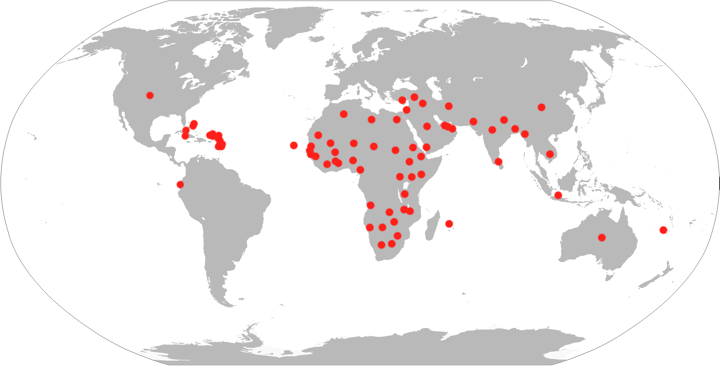Last year, renowned treethnographer Garik Roblerks noticed that two books on the evolution of language had strikingly similar covers. Both Christiansen & Kirby’s Language Evolution and Fitch’s The Evolution of Language boasted an acacia tree in the sunset. On closer inspection, these turned out to be different pictures of the same tree.

A comparison of the books
by Christiansen & Kirby (left) and Fitch (right)
Having spent a year tracking trees in Kenya, I can confirm that the tree is from Maasai Mara National Reserve. The tree has attracted a lot of attention since its entrance into the glamorous world of book cover design, and I observed some excited undergraduate linguists tying ribbons to its branches with messages such as “Thanks for the episodic memories” and “Dolphins next, please”.
Of course, this prompts the question

Distribution of tonal languages

Distribution of acacia trees
Quite remarkable, but this would just be a pointless, spurious statistic without a causal mechanism. I was then reminded that acacia trees produce tryptamines such as Dimethyltryptamine (DMT). These are psychedelic compounds that can cause sensory enhancement, euphoria, immersive experiences and radical perspective shifting. These are, of course, not only extremely useful in coming up with hypotheses about the origins of language, but exactly the kinds of mind-
So, I propose the acacia hypothesis of language evolution: Some primates got high and thought it would be a laugh to try and refer to objects using arbitrary signs.
However, the effects of acacia trees on culture have been felt more recently: Shanon (2008) suggests that Moses was under the influence of this naturally occurring smack when he heard the burning bush (an acacia!) talking to him. This is direct evidence for a link between acacia trees and linguistic inspiration.
In order to investigate the effect of acacia trees on language evolution, I extended an iterated learning experiment (Kirby, Cornish, Smith, 2008):
There were two conditions
The DMT condition performed above the control group for the majority of generations, suggesting that the acacia tree really does have an effect on cultural transmission (see below).

The composystemalexity drops significantly in the last generation for the DMT group. Looking at the 27 words produced in the last generation, the control group looks as you would expect, although a higher WWMI* than usual:
| nana | renana | banana |
| pajama | ninjana | binjana |
| bonjana | zombana | bombana |
| bill | ben | weed |
| pogle | andy | pandy |
| rag | tag | bobtail |
| booba | kiki | blicket |
| wug | dax | leedle |
| john | mary | book |
The words in the DMT condition were seemingly random clusters of letters and symbols. They had, quite possibly, just lost it. However, I made a startling discovery when I lined up the words one after another:
|
........................................8ZO....Z..Z............................D ..................................8OOMMMZ.Z.ZDOD8M8NMZOZ..O.Z..................D .............Z.O....ND8..8ZZ..O8.ZMMNNMMNMMMMNMMMMMMMMMDNONNDMDOOD.............D ...............8MMMMMMMMMMMMMMMMMMMMMMMMMMMMMMMMMMMMMMMMMMMMMMMMMMMNDD..O......D ...............Z8MMMMMMMMMMMMMMMMMMMMMMMMMMMMMMMMMMMMMMMMMMMMMMMMMMMMMMMMM8NNO88 ................8..ZN8.MMMDNMMMMMMMMMMMMMMMMMMMMMMMMMMMMMMMMMMMMMMMMMMMMMMMMMMM8 ......................N...ZNMM.NN.MZ8NNMMMMMNMMMMMMMMMMMMMMMMMMMMMMMMMMMMMMMMMM8 .........ZMMMMN8..Z..Z.....8NDZNN8....O.D.O8MNMMMMMMMNMMMMMMMMMMMMMMMMMMMMMM.MMD .........NMMN8MMM8MZD8.......DZ..NMMN......ZZMMMMM.DNMNMMMMMMZNMMMMMMMN8NNND8Z88 .....................N.D.Z............MMMN..MMM.....DMZ.ODMMMMMMZ8..ZOZ88MD....8 ........................ON................ONMM.N.....MMMOZ.DMNZ....Z.Z......Z..D ............................N=..............MM........M.MMNOMZ...............Z.D ..............................M.............MD.........MOMMM...................D ..............................NDNMMMD......NMMM........MMMMM.8.................D ......................................MMMD....NMM...MMMMM....ZDD...............D ...................=...........................ZMMMMMN8........................8 ..............:,,,,,,,,:=.......................MMM............................8 ............:,,,,,,,,,,,,:......................DMM...........................Z8 ...........::,,,,,,,,,,,,:~......................MMN........................ZZZ8 ..........=:::::::::::::,::=.....................MMM........................ZZZ8 ..........~::,,,,,,,,,,,,::=.....................MMM......................ZZZZZ8 ..........=:,,,,,,,,,,:::::.....................ZMMM.....................ZZZZZZ8 ...........~::::::::::::::=.....................OMMM....................ZZZZZZZ8 ............~~::::::::::~........................MMM........................ZZZ8 ..............==~~~~~~=..........................MMM...........ZOODDDNNNNNNDDD88 DDDDDD888888OZOZ..................ZZOOOO888888888DMMMDDDDDDNNNNNNNNNNNNNNMMMMMM8 NNDDDDDDDD88888888888888888888888DDDDDDDD8DDDDDDDDMMMNNNNNNNNNNNNNNNNMMMMMMMMMM8 |
The language had transcended all communicative pressures and evolved to fit the cognitive biases of its users. It turns out that an important bias may be acacia trees in the sunset.
Christiansen, M. and Kirby, S. (2003) Language Evolution. Oxford University Press.
Fitch, W. T. (2010) The Evolution of Language. Cambridge, UK: Cambridge University Press.
Kirby, Cornish, Smith (2008) “Cumulative cultural evolution in the laboratory: An experimental approach to the origins of structure in human language.” PNAS, 105(3) 10681-10686.
Shanon, B. (2008) “Biblical Entheogens: a Speculative Hypothesis.” Time and Mind, 1(1) 51-74.
| Augmented Things You Didn’t Know You Didn’t Know |
|
| Now Playing at the Move- |
|
| SpecGram Vol CLXII, No 4 Contents |